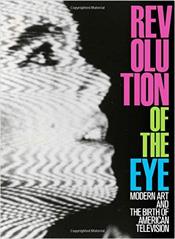Looking at TV as Modern Art
In 1961, TV was infamously deemed a “vast wasteland” by FCC then-chairman, Newton N. Minow. Before that, references to the device were along the lines of “the idiot box.” But what Newton and others missed was that as a new medium — an electronic one — TV was first, at its core, one thing.
It was modern art.
That’s what an endlessly fascinating exhibit, “Revolution of the Eye: Modern Art and the Birth of Television,” now on display at the Addison Gallery of American Art at the Phillips Academy in Andover, Massachusetts, explores.
Through artifacts and many, many excellent clips from TV’s evolution, the show is a surprising and fresh look at early television’s place in mid-20th century art, alongside some of that century's more influential artists and styles.
 We might not have been aware of it, but early pioneers such as Ernie Kovacs and later, the art directors of The Ed Sullivan Show, were liberally riffing, matching up the visual style of television with the like-minded concerns of the artists of the day whose works were shuttered away in galleries and museums.
We might not have been aware of it, but early pioneers such as Ernie Kovacs and later, the art directors of The Ed Sullivan Show, were liberally riffing, matching up the visual style of television with the like-minded concerns of the artists of the day whose works were shuttered away in galleries and museums.
On exhibit through 2017, the show, curated by Dr. Maurice Berger, began at the Jewish Museum in New York and will finish its tour at the University of Chicago. If you’re not near any of the upcoming stops, you can see samples of TV’s artistic moments here, at The Jewish Museum website, or you can get the excellent catalog of the show here at Amazon.
Entering “Revolution of the Eye,” you will first find, of course, six-foot-high wall-sized decals of the CBS logo — the all-seeing eye (inspired, as David Bianculli reminds, by Shaker artwork and surrealist painter Rene Magritte) originated by CBS art director William Golden. (His 1951 version is seen at top.)
Much of the early part of the exhibition is dedicated to CBS’s early commitment to the design and presentation of its printed ads, illustrated title cards (The Remarkable Incident at Carson Corners, 1953, by Richard Lidner, above) and its special promotional material, like cufflinks and match boxes with the CBS eye imprint. There’s also the original scale model of the company's 1962 New York headquarters by renowned modernist Eero Saarinen, eventually dubbed “Black Rock.”
From the CBS collection, the exhibit covers clips of Kovacs' “Dada” art-inspired bits from the 1950s and '60s. There is also one room entirely dedicated to The Twilight Zone, showing how the series amped up Rod Serling’s political and sociological themes with an overlay of Surrealist motifs that made his psychodramas all the more haunting.
The best parts of “Revolution of the Eye” may be the smaller moments, showing samples of the artists themselves who began working in the medium. Graphic designer Saul Bass’ title sequence for Playhouse 90 (1956) and his majestic opening credits for the TV presentation of John F. Kennedy’s collected essays, Profiles in Courage (1964), featuring a ringing iron bell on a wheel, are the most notable of these.
On par with these are clips of television commercials borrowing directly from the art of the day -- one very memorable favorite being the Burlington Mills commercial (starting in 1970, but it ran for years) connected directly to the Op Art works of Agnes Martin.
To put a point on its subject, the Addison has included many works from its own collection, including sketches by Marcel Duchamp, Alexander Calder and others alongside TV clips, to visually connect you from pioneering in still media to the electronic form.
The most astonishing of these is a room dedicated to the stage craft of the art directors of The Ed Sullivan Show (1948-1971), where there are large abstract minimalist sculptures placed in front of clips of The Four Tops, The Beatles, Sammy Davis and Vanilla Fudge — who all performed in front of similarly styled sets that had the freshness and uncomplicated energy of the performers themselves.
If there is perhaps one minor quibble with “Revolution of the Eye,” it might be that while it looks back authoritatively on television's roots in modern art, it doesn’t sign off with a look forward, connecting those beginnings to the new age of shows, many of which are similarly and firmly grounded in artistic presentation.
Breaking Bad's titles were graphically structured around the periodic table of elements. And of course, Mad Men, an examination of America’s ascension in the 1950s and '60s, came to us draped in this exhibition’s same subject: the daring optimism of mid-20th century modernism.